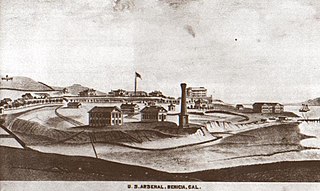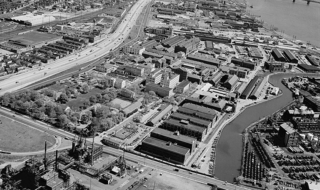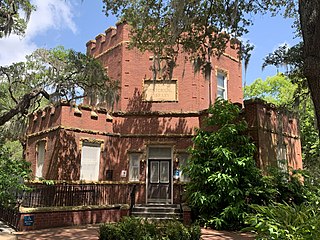The National Register of Historic Places (NRHP) is the United States federal government's official list of districts, sites, buildings, structures and objects deemed worthy of preservation for their historical significance. A property listed in the National Register, or located within a National Register Historic District, may qualify for tax incentives derived from the total value of expenses incurred in preserving the property.

Columbia, formerly known as Point of Fork, is an unincorporated community in Fluvanna County, Virginia, United States, at the confluence of the James and Rivanna rivers. Following a referendum, Columbia was dissolved as an incorporated town – until that time the smallest in Virginia – on July 1, 2016. As of the 2010 census, the town's population was 83, up from 49 at the 2000 census.

The Tower Building of the Little Rock Arsenal, also known as the Main Building of the U.S. Arsenal at Little Rock, or Headquarters Building of the Little Rock Barracks, is the home of the MacArthur Museum of Arkansas Military History. It is also a part of the MacArthur Park Historic District, in Little Rock, Arkansas.

Fort Stevens was an American military installation that guarded the mouth of the Columbia River in the state of Oregon. Built near the end of the American Civil War, it was named for a slain Civil War general and former Washington Territory governor, Isaac I. Stevens. The fort was an active military reservation from 1863–1947. It is now listed on the National Register of Historic Places.

The Philadelphia Naval Asylum is a complex of buildings at Gray's Ferry Avenue in Philadelphia, Pennsylvania. Built in 1827 as a hospital, it later housed the Philadelphia Naval School, served as a home for retired sailors for the United States Navy from 1834 to 1976, and was ultimately redeveloped as luxury condominiums. The site was placed on the National Register of Historic Places and designated a National Historic Landmark in 1971, primarily for its architecture.

The Rock Island Arsenal comprises 946 acres (383 ha), located on Arsenal Island, originally known as Rock Island, on the Mississippi River between the cities of Davenport, Iowa, and Rock Island, Illinois. It lies within the state of Illinois. Rock Island was previously used as the summer camp site for Sauk Native Americans, and the dispute over tribal ownership led to the Black Hawk War of 1832, after the primary leader of the Sauk, Black Hawk. It is now home of First Army headquarters, and the US Army's Center of Excellence for Additive Manufacturing. The island was originally established as a government site in 1816, with the building of Fort Armstrong. It is now the largest government-owned weapons manufacturing arsenal in the United States. It has manufactured military equipment and ordnance since the 1880s. In 1919–1920 one hundred of the Anglo-American or Liberty Mark VIII tanks were manufactured, although too late for World War I. It is designated as a National Historic Landmark.

The Benicia Arsenal (1851–1964) and Benicia Barracks (1852–66) were part of a large military reservation located next to Suisun Bay in Benicia, California. For over 100 years, the arsenal was the primary US Army Ordnance facility for the West Coast of the United States.

Fort Lesley J. McNair is a United States Army post located on the tip of Greenleaf Point, the peninsula that lies at the confluence of the Potomac River and the Anacostia River in Washington, D.C. To the peninsula's west is the Washington Channel, while the Anacostia River is on its south side. Originally named Washington Arsenal, the fort has been an army post for more than 200 years, third in length of service, after the United States Military Academy at West Point and the Carlisle Barracks. The fort is currently named for General Lesley J. McNair, who was killed in action in World War II.

The Frankford Arsenal is a former United States Army ammunition plant located adjacent to the Bridesburg neighborhood of Northeast Philadelphia, Pennsylvania, north of the original course of Frankford Creek.

The boundary markers of the original District of Columbia are the 40 milestones that marked the four lines forming the boundaries between the states of Maryland and Virginia and the square of 100 square miles (259 km²) of federal territory that became the District of Columbia in 1801. Working under the supervision of three commissioners that President George Washington had appointed in 1790 in accordance with the federal Residence Act, a surveying team that Major Andrew Ellicott led placed these markers in 1791 and 1792. Among Ellicott's assistants were his brothers Joseph and Benjamin Ellicott, Isaac Roberdeau, George Fenwick, Isaac Briggs and an African American astronomer, Benjamin Banneker.

The South Carolina Governor's Mansion is a historic U.S. governor's mansion in the Arsenal Hill neighborhood of Columbia, South Carolina and the official residence of the Governor of South Carolina. It is a Federal style home influenced by British Colonial plantations. The building has a white stucco exterior and originally served as faculty quarters for the Arsenal Academy, which together with the Citadel Academy in Charleston formed the South Carolina Military Academy. The Arsenal was burned along with the city of Columbia by Sherman's forces in February, 1865; the structure was the only surviving building and became South Carolina's executive mansion in 1868. On June 5, 1970, the building was registered with the U.S. National Register of Historic Places. The mansion is located on a single city block, and is surrounded by magnolia plants, elm and oak trees, and various other plants. It is accessed by a circular driveway around a fountain in front on the residence's main entrance. The building has a flat roof and a large central pavilion around the main entrance. The mansion has 15 rooms. It is located in Columbia Historic District I. The mansion is currently occupied by Governor Henry McMaster and his family.

The Watertown Arsenal was a major American arsenal located on the northern shore of the Charles River in Watertown, Massachusetts. The site is now registered on the ASCE's List of Historic Civil Engineering Landmarks and on the U.S.'s National Register of Historic Places, and it is home to a park, restaurants, mixed use office space, and currently serves as the national headquarters for athenahealth.

The Pentagon Barracks, also known as the Old United States Barracks, is a complex of buildings located at the corner of State Capitol Drive and River Road in Baton Rouge, Louisiana, in the grounds of the state capitol. The site was used by the Spanish, French, British, Confederate States Army, and United States Army and was part of the short-lived Republic of West Florida. During its use as a military post the site has been visited by such notable figures as Zachary Taylor, Lafayette, Robert E. Lee, George Custer, Jefferson Davis, and Abraham Lincoln.

The Eighth Regiment Armory, located in the Black Metropolis-Bronzeville District of Chicago, Illinois, was the first armory in the United States built for an African-American military regiment, known as the "Fighting 8th". The building later was used by a division of the Illinois National Guard, and during World War I was incorporated into the US Infantry. After closing the armory in the early 1960s, it became the South Central Gymnasium. In 1999, following an extensive renovation, it was reopened as a public high school military academy. The restoration and conversion into a school has been recognized by the National Trust for Historic Preservation.

The Charleston Arsenal was a United States Army arsenal facility in Charleston, South Carolina, seized by state militia at the outbreak of the American Civil War. On June 21, 1996, it was added to the National Register of Historic Places as Porter Military Academy.

Fort Logan H. Roots was a military base located in North Little Rock, Arkansas, set on a high promontory overlooking the Arkansas River. The land was traded to the Federal Government in 1892 in exchange for the property now known as MacArthur Park, in Little Rock, which had been a military arsenal since the 1830s when Arkansas was a territory. The base was named for Congressman Logan H. Roots in recognition for his work in the negotiations.

The building of the United States Court of Military Appeals, formerly known as the District of Columbia Court of Appeals, is a historic building located at 450 E St., Northwest, Washington, D.C.. It is regarded as "a particularly fine and remarkably early example of revived Greek Revival architecture."

The South Carolina State Arsenal in Charleston, South Carolina was built in 1829 after the 1822 slave revolt led by Denmark Vesey. In 1842 the South Carolina Military Academy, a liberal arts military college, was established by the state legislature, and the school took over the arsenal the following year as one of 2 campuses, the other being the Arsenal Academy in Columbia, South Carolina. The school became known as the Citadel Academy because of the appearance of its building. From 1865 to 1881, during Reconstruction, Federal troops occupied the Citadel, and the school was closed. Classes resumed in 1882 and continued in this building until the school was relocated to a new campus on the banks of the Ashley River in 1922.



















